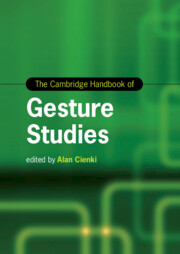Book contents
- The Cambridge Handbook of Gesture Studies
- Cambridge Handbooks in Language and Linguistics
- The Cambridge Handbook of Gesture Studies
- Copyright page
- Contents
- Figures
- Tables
- Contributors
- Introduction
- Part I Gestural Types: Forms and Functions
- Part II Ways of Approaching Gesture Analysis
- 6 Contributions to the Study of Visible Action as Utterance: A Fifty-Year Retrospective
- 7 Systems of Gesture Coding and Annotation
- 8 A Toolbox of Methods for Gesture Analysis
- 9 The Gestural Sign: A Concrete and Reasoned Analysis of Co-Speech Gesture
- 10 Creation and Analysis of the Multimedia Russian Corpus for Gesture Research
- 11 A Kinesiological Approach to Gesture Analysis
- 12 Motion-Tracking Technology for the Study of Gesture
- Part III Gestures and Language
- Part IV Gestures in Relation to Cognition
- Part V Gestures in Relation to Interaction
- Index
- References
12 - Motion-Tracking Technology for the Study of Gesture
from Part II - Ways of Approaching Gesture Analysis
Published online by Cambridge University Press: 01 May 2024
- The Cambridge Handbook of Gesture Studies
- Cambridge Handbooks in Language and Linguistics
- The Cambridge Handbook of Gesture Studies
- Copyright page
- Contents
- Figures
- Tables
- Contributors
- Introduction
- Part I Gestural Types: Forms and Functions
- Part II Ways of Approaching Gesture Analysis
- 6 Contributions to the Study of Visible Action as Utterance: A Fifty-Year Retrospective
- 7 Systems of Gesture Coding and Annotation
- 8 A Toolbox of Methods for Gesture Analysis
- 9 The Gestural Sign: A Concrete and Reasoned Analysis of Co-Speech Gesture
- 10 Creation and Analysis of the Multimedia Russian Corpus for Gesture Research
- 11 A Kinesiological Approach to Gesture Analysis
- 12 Motion-Tracking Technology for the Study of Gesture
- Part III Gestures and Language
- Part IV Gestures in Relation to Cognition
- Part V Gestures in Relation to Interaction
- Index
- References
Summary
In this chapter I discuss the role of motion-tracking technology in the study of gesture, both from a production perspective as well as for understanding how gestures support comprehension. I first give an overview of motion-tracking technologies in order to provide a starting point for researchers currently using or interested in using motion tracking. Next, I discuss how motion tracking has been employed in the past to understand gesture production and comprehension, as well as how it can be utilized for more complex experiments including virtual reality. This is not meant as a comprehensive review of the field of motion tracking, but rather a source of inspiration for how such methodologies can be employed in order to tackle relevant research questions. The chapter is concluded with suggestions for how to build upon previous research, asking new, previously inaccessible questions, and how motion-tracking technology can be used to move toward a more replicable and quantitative study of gesture.
- Type
- Chapter
- Information
- The Cambridge Handbook of Gesture Studies , pp. 306 - 332Publisher: Cambridge University PressPrint publication year: 2024

